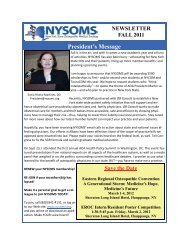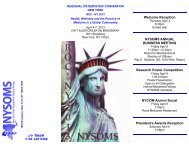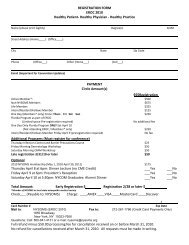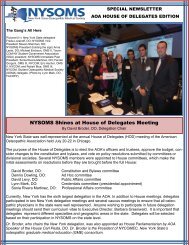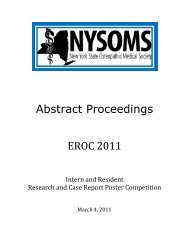Lower Extremity Neuropathies
Lower Extremity Neuropathies
Lower Extremity Neuropathies
You also want an ePaper? Increase the reach of your titles
YUMPU automatically turns print PDFs into web optimized ePapers that Google loves.
<strong>Lower</strong> <strong>Extremity</strong><br />
<strong>Neuropathies</strong><br />
March 25, 2009
Learning Objectives<br />
� Describe and Discuss Common<br />
entrapment neuropathies of the lower<br />
extremity<br />
� Analyze the relevant anatomy of these<br />
neuropathies<br />
� Review possible Osteopathic treatments<br />
for these neuropathies
Definitions<br />
� Peripheral Neuropathy<br />
� Compression Neuropathy<br />
� Entrapment Neuropathy<br />
� “Any of a group of neuropathies,…,in which a<br />
peripheral nerve is injured by compression in its<br />
course through a fibrous or osseofibrous tunnel<br />
or at a point where it abruptly changes its course<br />
through deep fascia over a fibrous or muscular<br />
band.” Dorlands, 27th
Definitions<br />
� Peripheral Neuropathy<br />
� Focal<br />
� General<br />
� Disease<br />
� Drugs<br />
� Genetic<br />
� Nutrition<br />
� Environmental
Definitions<br />
� Radiculopathy<br />
� Specialized form of neuropathy which occurs<br />
at the root (radicule) of the nerve as it leaves<br />
the spinal cord.<br />
� Segmental Neuropathy<br />
� AKA Segmental demyelinating neuropathy<br />
� Loss of myelin sheath, changes conduction<br />
pattern
Case #1<br />
� 72 year old dentist, complains of dragging<br />
his right toe. Mild pain in his right knee<br />
� Hx: Started about three weeks ago. Is<br />
progressive.<br />
� Weekend previous, was washing van,<br />
moving some furniture to close summer<br />
cottage, not much else.
Case #1<br />
� You think (differential)<br />
� Diabetes?<br />
� Alcoholism (B12 def?)<br />
� Sitting position, legs<br />
crossed?<br />
� Recent wt loss<br />
� No history, no recent<br />
changes<br />
� One drink daily in<br />
evening x 30 years<br />
� Rarely crosses legs,<br />
usually ankles if at all<br />
� 155# x 25 years
Case #1<br />
� Washing van?<br />
� He is about 5‟8”,<br />
stretching to get<br />
top of windows<br />
and parts of roof.<br />
On tiptoes…
Case #1<br />
� On Tiptoes…<br />
� Biceps femoris<br />
contracts<br />
� Soleus contracts<br />
� Gastroc contracts<br />
� Compress nerve<br />
� Loss of<br />
dorsiflexion
Common Peroneal<br />
� Divides into Deep &<br />
Superficial<br />
� Deep innervates<br />
� Tibialis Anterior<br />
� Extensor digitorum<br />
longus/brevis<br />
� Extensor hallicus<br />
longus
Innervation of Anterior Compartment = Deep Peroneal
Common Peroneal Compression<br />
� Third most common compression<br />
neuropathy<br />
� Etiology<br />
� Leg hooked over rail (bedridden, comatose,<br />
post operative<br />
� Strawberry Pickers palsy<br />
� Time spent in squatting position<br />
� Ankle Sprains (always check fibular head)
Common Peroneal Compression<br />
� New Meditators or New to Yoga<br />
� “lotus position”<br />
� Natural Childbirth<br />
� Time spent squatting<br />
� Holding knees (wrist can compress at fibular<br />
head)<br />
� Idiopathic
Common Peroneal Compression<br />
� Treatment?<br />
� Posterior fibular head<br />
� Muscle Energy on gastroc/soleus<br />
� Muscle Energy on Biceps femoris<br />
� How do you know when you are done?<br />
� Pain resolves<br />
� Dorsiflexion returns to normal
Case #2<br />
� A 34 year old female stockbroker comes to your<br />
office with a complaint of foot pain. On<br />
weekends she plays volleyball with a few of her<br />
old teammates from college in an amateur<br />
league.<br />
� The pain started the week after a teammate<br />
came down on her foot. She did not notice much<br />
pain until later in the week.
Case #2<br />
� She denies any diabetic, alcohol,<br />
nutritional or other problem.<br />
� Systemic signs of disease are absent.<br />
� On examination<br />
� Patellar reflex intact<br />
� Achilles reflex intact but when you dorsiflex<br />
her foot, she winces.
Case #2<br />
� You pursue the pain and she notes that the tap<br />
was not painful but when your hand grasped her<br />
foot, the pain was on the dorsum of the foot.<br />
� You test your hypothesis by plantar-flexing her<br />
foot which exacerbates her pain.<br />
� Sensory evaluation of the foot reveals<br />
numbness between the first and second toes<br />
and not much further.
Anterior Tarsal Tunnel Syndrome<br />
� You further localize the compression and<br />
the nerve by dorsiflexing the foot and then<br />
asking her to dorsiflex her big toe.<br />
Attempting to do so exacerbates the pain.<br />
� Her history is positive for pain at night,<br />
which has been waking her from sleep<br />
more frequently recently.
Anterior Tarsal<br />
Tunnel Syndrome<br />
� Which nerve is it?<br />
� Medial branch of the deep<br />
peroneal?<br />
� Lateral branch of the deep<br />
peroneal?<br />
� Which nerve innervates<br />
the extensor digitorum<br />
brevis?<br />
� Where is the problem?
Anterior Tarsal<br />
Tunnel Syndrome<br />
The Problem:<br />
Compression of the nerve at the<br />
inferior flexor retinaculum<br />
-injury<br />
-talonavicular dysfunction<br />
-prolonged plantar flexion<br />
-compression from shoes<br />
shoe straps<br />
shoes tied too tight
Summary:<br />
Anterior Tarsal Tunnel<br />
Syndrome
Treatment<br />
� Remove compressive forces<br />
� Myofascial release of inferior flexor<br />
retinaculum<br />
� Release talonavicular joint – Traction tug<br />
� Hiss whip for navicular, cuneiforms, 1 st –<br />
2 nd metatarsal
Tarsal Tunnel Syndrome<br />
(NOT anterior tarsal syndrome)<br />
� Difficult Diagnosis<br />
� Pain on plantar surface of the foot<br />
� Not very specific<br />
� Does not affect large foot muscles<br />
� Difficult to test toe intrinsics…<br />
� Extrinsics compensate very well<br />
� May be described as burning, itching,<br />
tightness, numbness.<br />
� Gait seldom affected
Tarsal Tunnel Syndrome<br />
Calcaneal branches of posterior<br />
tibial<br />
-many variations<br />
some branch above retinaculum<br />
some branch through retinaculum<br />
very few branch distal to<br />
retinaculum.
Tarsal Tunnel Syndrome<br />
� Etiology<br />
� Trauma to medial malleolus – MVA<br />
� Congenital<br />
� Autoimmune<br />
� RA, Ankylosing spondylitis<br />
� Diabetes<br />
� Tumors<br />
� Lifestyle (long periods of standing…)
Treatment<br />
� Tibial ligaments/fascia<br />
� May be posterior to normal position<br />
� Talo-calcaneus tx<br />
� Stretch the ligaments<br />
� Roof of the „tunnel‟<br />
� Talonavicular
Saphenous Nerve Syndrome<br />
� Athletes<br />
� Body builders<br />
� Femoral Arteriography<br />
� Vascular surgery<br />
� Higher than average – thrombophlebitis<br />
� Inflammation causes nerve & vein to expand<br />
in canal, increases compression
Saphenous Nerve Syndrome<br />
Saphenous N<br />
Branch of Femoral<br />
-separates just below inguinal<br />
ligament<br />
-may be compressed at vasoadductor<br />
membrane
Saphenous Nerve Syndrome<br />
Saphenous Nerve Compression<br />
-Sartorius<br />
-Between Adductor longus &<br />
vastus medialis<br />
Saphenous Nerve below knee<br />
-infrapatellar branch<br />
-medial leg and foot –<br />
descending branch
Saphenous Nerve Syndrome<br />
� Clinical symptoms<br />
� Medial leg pain when walking<br />
� Medial knee pain<br />
� May be painful on resisted adduction<br />
� Tinel‟s anywhere along path of nerve
Treatment<br />
� Muscle energy<br />
� Sartorius<br />
� Adductor longus<br />
� Vastus medialis<br />
� Fascial Treatments<br />
� Inguinal area<br />
� Vaso-adductor membrane<br />
� Medial knee fascia
Meralgia Paresthetica<br />
� Compression of the lateral femoral cutaneous<br />
nerve, usually under the inguinal ligament<br />
� Sensory only<br />
� Symptoms include<br />
� Numbness on anterolateral thigh<br />
� Burning pain in same area<br />
� Hypesthesia to the point of not putting anything in the<br />
pockets over the area<br />
� Late sign: trophic skin changes
Meralgia Paresthetica<br />
� Causes<br />
� Very intense athletics<br />
� Obesity<br />
� Tight girdle, tight clothing<br />
� Seat belt misplacement or post accident<br />
� Anatomic anomaly, ie through the sartorius
Meralgia Paresthetica<br />
� Treatment<br />
� Relieve tension in Pelvic Diaphragm<br />
� Muscle energy to Psoas<br />
� Myofascial release to inguinal canal<br />
� Find and fix lumbar, innominate and sacral<br />
problems<br />
� Muscle energy or MFR to sartorius
Meralgia Paresthetica<br />
� Usual area of<br />
entrapment is at<br />
inguinal canal
Possible distribution areas
Taken from a lecture by Jim Bailey, MD<br />
http://www.utmem.edu/gim/smalltalks/le-neuropathy.pdf<br />
Sciatic Neuropathy<br />
Cause: Trauma at sciatic notch or gluteal<br />
region (hip dislocation, fracture, or<br />
replacement),<br />
prolonged bed rest, deep-seated pelvic mass,<br />
piriformis syndrome<br />
Sxs: <strong>Lower</strong> leg pain and<br />
weakness<br />
Signs: Sensory loss in peroneal, tibial, and<br />
sural territories, normal patellar reflex, foot<br />
drop less common<br />
Tarsal Tunnel Syndrome –Tibial nerve entrapment<br />
Cause: Fracture or dislocation of talus, calcaneus, medial<br />
malleolus, rheumatoid arthritis, tumor, diabetes alone?<br />
Sxs: Aching, burning, numbness, tingling on plantar foot,<br />
distal foot, toes, and occasionally heel, paresthesias<br />
and/or sensory loss<br />
Signs: Positive Tinel's sign over nerve posterior to medial<br />
malleolus; sensory loss on plantar foot; atrophy of foot<br />
muscles if severe<br />
Femoral Neuropathy<br />
Cause: Mid thigh or pelvis trauma (hip, pelvis or femur fracture,<br />
mass, ischemic nerve infarction or, hip replacement, lithotomy<br />
position, diabetes mellitus)<br />
Sxs: Leg pain, Quadriceps weakness and sensory loss over<br />
thigh and shin<br />
Signs: sensory loss, decreased patellar reflex<br />
Lateral cutaneous nerve of thigh<br />
Meralgia Paresthetica<br />
Cause: Compression of lateral femoral cutaneous<br />
nerve at inguinal ligament Obesity, tight fitting belts,<br />
idiopathic<br />
Sxs: Paresthesias and pain radiating down the lateral<br />
thigh to knee, paresthesias and/or sensory loss<br />
Signs: Minimal sensory loss<br />
Common Peroneal Neuropathy<br />
Cause: Compression just below fibular head from prolonged<br />
lying, leg crossing, squatting, leg cast<br />
Sxs: Foot drop, paresthesias and/or sensory loss<br />
Signs: Foot drop/weakness on foot dorsiflexion and eversion;<br />
sensory loss on dorsum of foot<br />
Distal Peroneal Neuropathy<br />
Cause: Trauma to dorsum of foot or ankle/distal peroneal nerve, tightfitting<br />
shoe rim or strap<br />
Sxs: Dorsal foot paresthesias and/or sensory loss<br />
Signs: Minimal sensory loss
References<br />
� Minoo Hadjari Hollis, MD, David E Lemay, MD, Robert P Jensen, MD. Nerve Entrapment Syndromes of the<br />
<strong>Lower</strong><br />
� <strong>Extremity</strong>, emedicine<br />
� Goroll AH, May LA, Mulley AG. Primary Care Medicine. READ CHAPTER 154 “Approach to Minor<br />
Orthopedic Problems<br />
� of the Foot and Ankle”.<br />
� Seward B Rutkove, MD Overview of lower extremity peripheral nerve syndromes, UptoDate<br />
� Wieman TJ, Patel VG: Treatment of hyperesthetic neuropathic pain in diabetics. Decompression of the<br />
tarsal tunnel. Ann Surg 1995 Jun; 221(6): 660-4; discussion 664-5.<br />
� E. DiGiovanna S. Schiowitz, D. Dowling - An Osteopathic Approach to Diagnosis and Treatment Third<br />
Edition, Lippincott Williams & Wilkins





